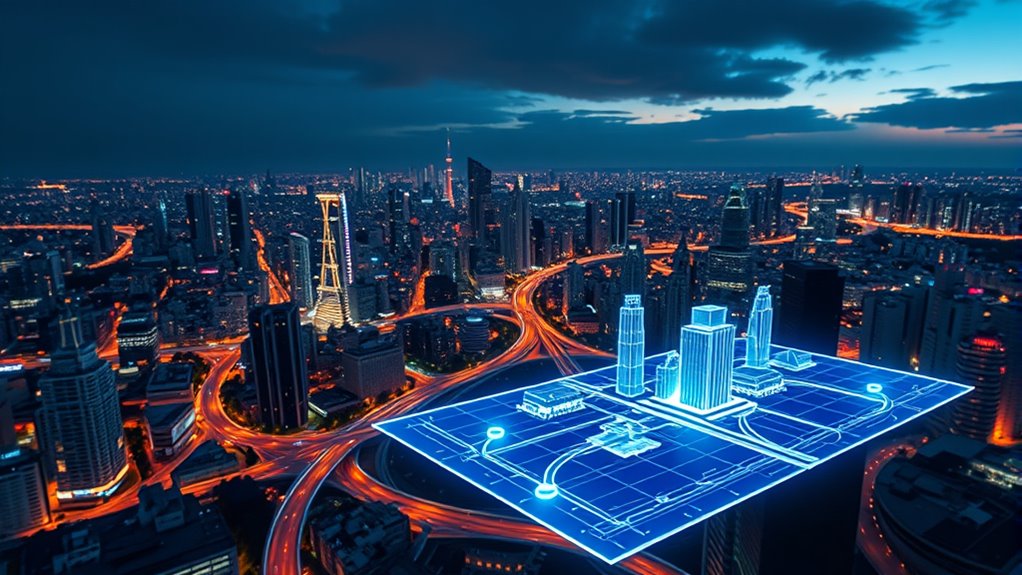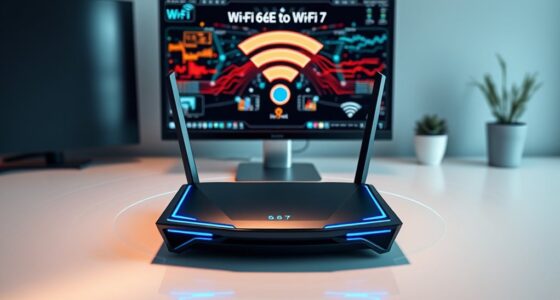Digital twins are virtual models of city infrastructure, leveraging real-time data to improve urban management. They help you monitor transportation, optimize energy, manage waste, and enhance water resources efficiently. With sensors and smart technology, these models enable proactive maintenance, safety alerts, and better decision-making, promoting sustainability and resilience. As cities adopt digital twins worldwide, understanding their potential can transform how you approach urban challenges—if you want to explore their full impact, keep going.
Key Takeaways
- Digital twins create virtual models of urban assets, enabling real-time monitoring, simulation, and operational optimization in smart cities.
- They facilitate data integration across departments, improving decision-making and enabling proactive infrastructure management.
- Digital twins support urban planning, environmental impact assessment, and scenario testing to enhance city resilience and sustainability.
- They leverage IoT, AI, and 5G technologies to provide accurate, responsive insights for city management.
- Despite challenges like data integration and costs, digital twins are transforming city efficiency, safety, and citizen engagement.
Understanding Digital Twins and Their Core Functions
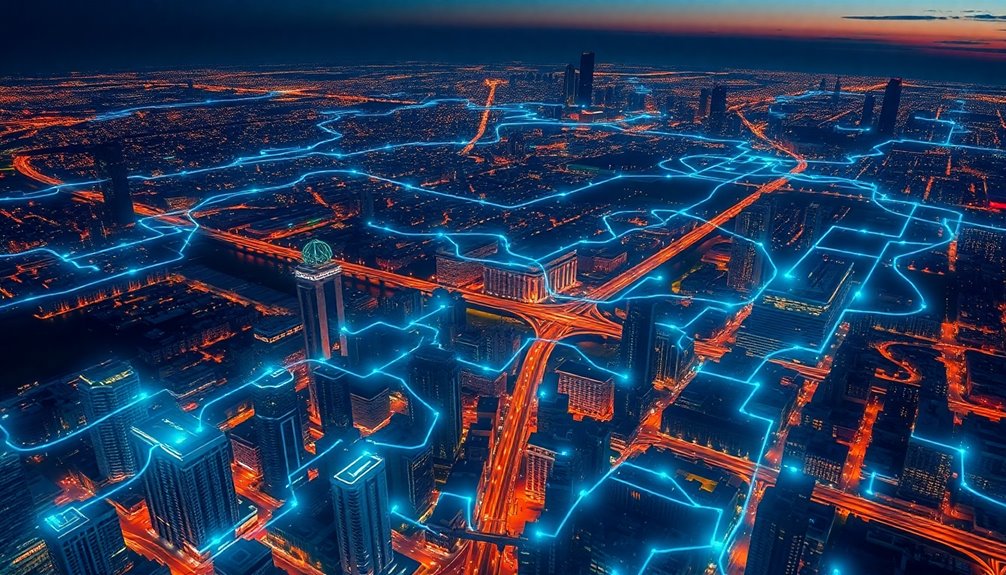
Have you ever wondered how cities can monitor and manage their complex systems more effectively? Digital twins are virtual models that mirror physical objects, environments, or systems throughout their entire lifecycle. They use real-time sensor data to replicate behavior, features, and functions of their physical counterparts. This creates a two-way data flow: sensors send data to the digital twin, and insights from the model can influence the physical asset. Unlike simple simulations, digital twins handle multiple processes at once and update continuously for ongoing analysis. They’re used to monitor performance, run simulations, predict failures, and optimize operations. These virtual models help cities enhance efficiency, safety, and sustainability by providing accurate, real-time insights into their infrastructure and assets. Incorporating high-resolution data and sensor integration into digital twins significantly improves their accuracy and usefulness in managing urban systems. Additionally, leveraging AI safety measures can help ensure the reliability and security of these complex digital models. Continuous data updates enable digital twins to adapt quickly to changing conditions, further increasing their effectiveness in urban management. Furthermore, enhancing data security protocols is essential to protect sensitive information within these digital environments.
How Digital Twins Transform Urban Management
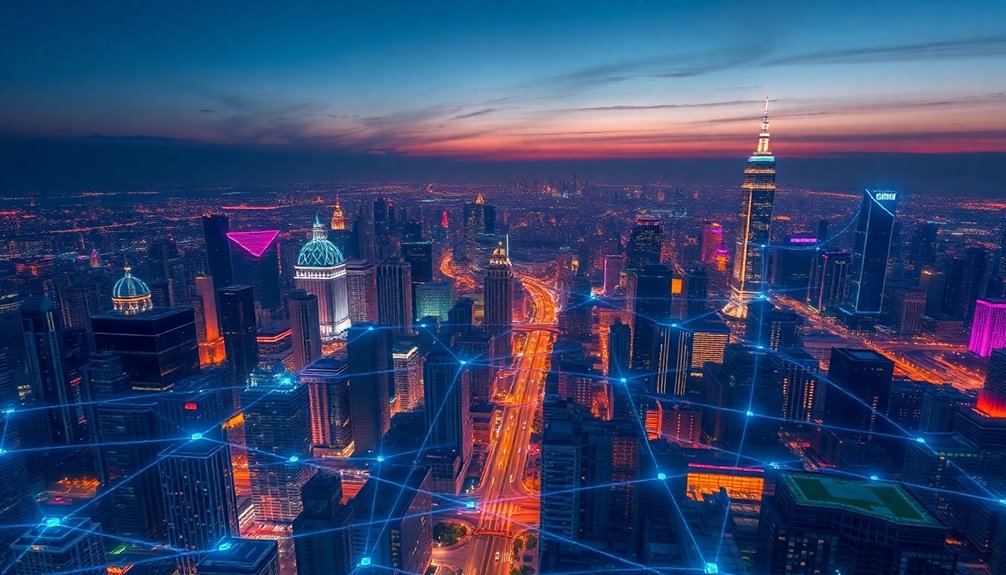
Digital twins revolutionize urban management by integrating and consolidating diverse data sources into a single, real-time visual platform. You’ll have instant access to maps, utility info, traffic, and demographic data, replacing fragmented systems with a centralized digital model. This integration facilitates data interoperability, enabling different systems and departments to communicate seamlessly. It improves data accessibility for multiple departments, enabling them to react quickly to changes or incidents. Shared visual context reduces misunderstandings and speeds up decision-making, especially in maintenance, emergency response, and infrastructure management. You can simulate urban scenarios in 3D, testing new developments, traffic patterns, or emergency plans before implementation. Predictive analytics forecast how modifications impact utilities, transportation, and parking, helping you avoid costly surprises. Overall, digital twins streamline operations, enhance coordination, and support smarter, more sustainable urban management. Real-time data integration further enhances responsiveness by ensuring that all stakeholders work from the most current information available, which is essential for effective urban decision-making. Additionally, incorporating comprehensive data management practices ensures that the digital twin remains accurate and reliable over time.
Key Applications Driving City Efficiency and Sustainability

Key applications of digital twins substantially enhance city efficiency and promote sustainability by enabling real-time data-driven decision-making. In urban planning, digital twins create virtual models to simulate development projects, assess environmental impacts, and optimize land use, supporting sustainable growth. For transportation, they replicate traffic networks, helping you reduce congestion, optimize public transit, and plan maintenance by monitoring infrastructure with IoT sensors. Waste management benefits from digital twins that track waste flow, optimize collection routes, and prevent landfill overflow, reducing emissions. Water resource management uses real-time data to monitor supply networks, predict demand, and simulate flood or drought scenarios, ensuring long-term resilience. Infrastructure monitoring enables proactive maintenance and safety alerts, minimizing downtime and ensuring public safety. Additionally, the integration of home furnishings technology, such as smart mattresses and temperature-controlled systems, can contribute to overall urban comfort and sustainability efforts. Furthermore, urban infrastructure management is increasingly supported by digital twins, facilitating more efficient maintenance schedules and resource allocation. Incorporating public participation strategies into digital twin platforms can foster community involvement and transparency in urban development processes. These applications work together to build smarter, more sustainable cities, leveraging real-time data to make informed decisions and improve overall urban living conditions.
Overcoming Challenges in Implementing Digital Twin Technology
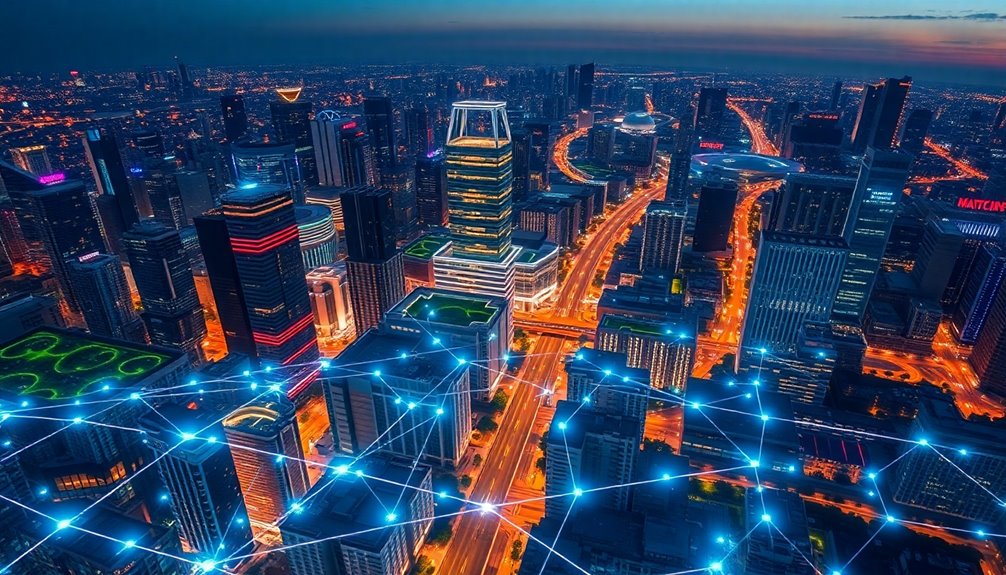
Implementing digital twin technology in smart cities involves steering multiple challenges that can hinder progress. You’ll face technical hurdles like integrating diverse data sources—from IoT sensors to legacy systems—requiring robust interoperability. Managing the massive data flow demands scalable storage and real-time synchronization to keep digital representations accurate. Data quality issues, incomplete datasets, and inconsistent formats can compromise reliability. Financially, high upfront costs for hardware, software, and infrastructure pose barriers, especially for smaller cities with limited budgets. Ongoing expenses for maintenance and skilled personnel add to the challenge. Regulatory concerns over privacy and security, along with evolving laws, require careful data governance. Additionally, understanding cybersecurity implications is vital to protect sensitive information from potential threats. The importance of data-driven marketing strategies can help cities justify investments by demonstrating value and efficiency improvements. Developing a comprehensive data governance framework is essential to ensure compliance and secure data handling. Moreover, fostering a culture of continuous learning and adaptation can help overcome resistance and accelerate adoption of new digital solutions. Finally, a skilled workforce is essential, but talent shortages and siloed collaboration can slow down implementation and reduce system effectiveness. Incorporating digital solutions, such as specialized consulting and project management support, can help address these hurdles effectively.
Notable Examples of Digital Twins in Global Cities
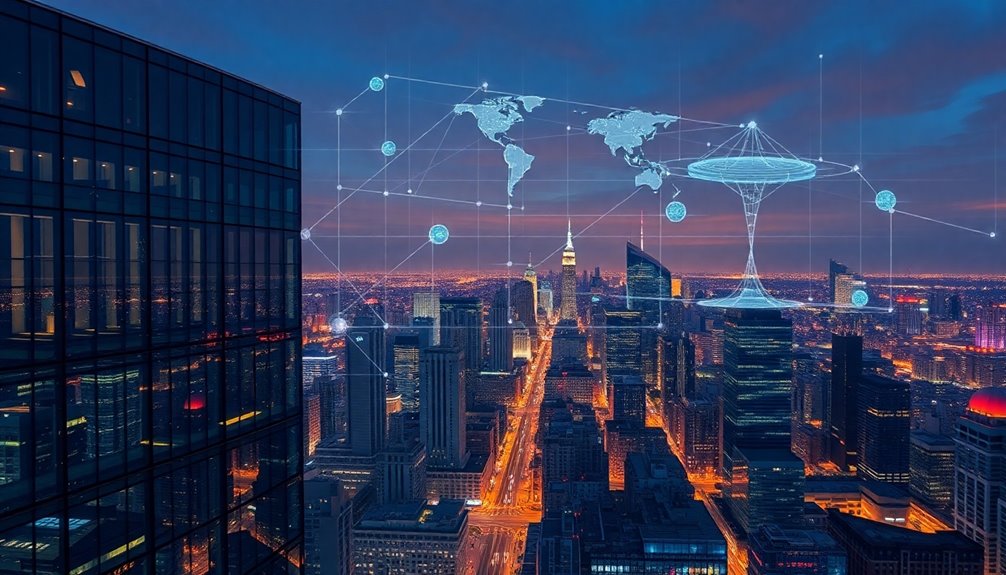
Cities worldwide are harnessing advanced digital twin platforms to address urban challenges and improve quality of life. Singapore’s Full-Scale Digital Twin, Virtual Singapore, replicates the entire city for real-time management, enhancing flood resilience, optimizing energy use, and analyzing traffic patterns to reduce congestion. Helsinki’s data-driven urban model integrates 3D city data and energy metrics to support sustainability, community feedback, and climate adaptation efforts. The UK’s National Digital Twin Programme links transportation, energy, and healthcare systems, enabling disaster simulations and policy testing for net-zero goals. In New York City, adaptive infrastructure models sea-level rise, optimizes transit, and enhances emergency responses. Espoo and Zurich’s specialized implementations visualize construction impacts, monitor environmental conditions, and improve urban sustainability through IoT-powered smart streetlights. Additionally, family backgrounds can influence public perception and the development of digital solutions tailored to community needs.
The Future of Digital Twins and Smart City Innovation
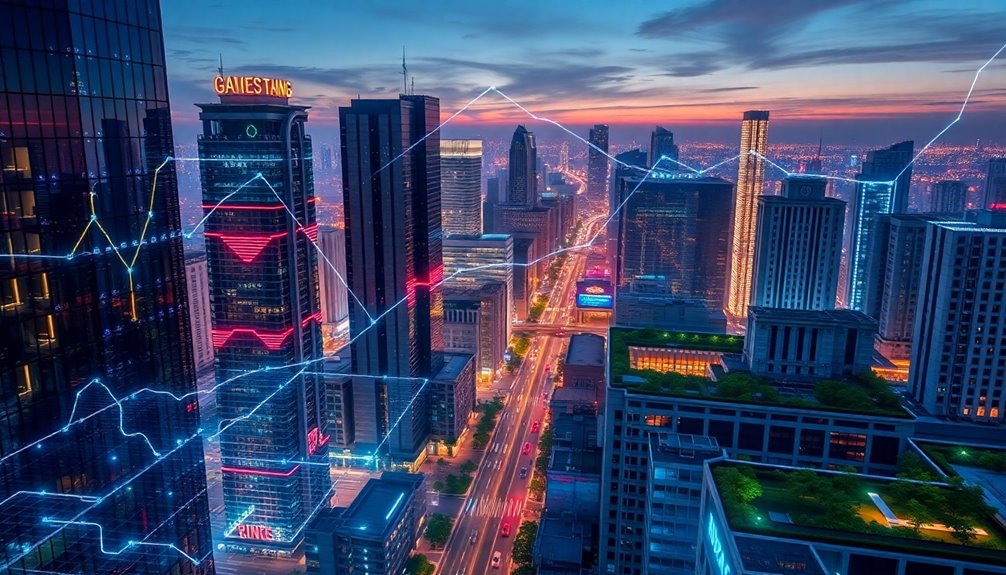
Digital twin technology is poised to revolutionize how urban areas manage their infrastructure and services, acting as a catalyst for smart city innovation. By enabling real-time simulation, monitoring, and optimization of critical systems like energy grids and traffic flow, digital twins drive smarter decision-making. The market for these tools is projected to surpass $48 billion globally by 2027, with cities like New York leading adoption. Integration of IoT, AI, and 5G enhances data accuracy and responsiveness, allowing city officials to test urban plans virtually, predict infrastructure failures, and reduce costs. Virtual reality interfaces foster stakeholder collaboration, while environmental and traffic data help optimize energy use and safety. Incorporating data integration techniques ensures that these models are continuously refined and remain reliable over time. Additionally, leveraging headphones technology, such as wireless or Bluetooth-enabled devices, can facilitate seamless communication and collaboration among urban planners and stakeholders during virtual simulations. Overall, digital twins will considerably boost urban sustainability, resilience, and citizen engagement in the future of smart cities.
Preparing for a Digital Twin-Integrated Urban Landscape

How can urban planners guarantee their digital twin initiatives are effective and sustainable? First, ensure data standardization and integration across all city sectors. Use interoperable formats like GIS, BIM, and sensor feeds to create cohesive, multi-layered models. Incorporate real-time data from IoT sensors for ongoing situational awareness and dynamic updates. Develop standard frameworks that promote seamless data exchange among stakeholders, fostering collaboration. Leverage digital twins for scenario testing—like traffic or environmental simulations—to anticipate impacts before implementation. Focus on sustainability by modeling energy-efficient buildings, optimizing resource use, and planning resilient infrastructure. Additionally, understanding the importance of sound design can improve the development of urban soundscapes within digital twins, supporting healthier and more liveable environments. By integrating diverse datasets and continuously updating digital twins, you’ll support informed decision-making, reduce risks, and ensure your smart city evolves sustainably and responsively.
Frequently Asked Questions
How Do Digital Twins Ensure Data Privacy and Security in Smart Cities?
You might wonder how digital twins protect data privacy and security. They use encryption to secure data, restrict access with strict controls, and monitor for any breaches. Regular updates fix vulnerabilities, while incident response plans prepare you for security incidents. Balancing accuracy with privacy is key, and adhering to laws like GDPR helps. Collaboration and standards development further enhance security, giving you confidence that your data remains protected in smart city environments.
What Are the Costs and Funding Models for Digital Twin Implementation?
You might find the costs of digital twin projects vary quite a bit, from $45,000 to over half a million dollars, depending on size and complexity. Funding often comes from government grants, private investors, or public-private partnerships. As you consider these investments, remember that they can lead to significant savings, improved efficiency, and long-term benefits. Tailoring the approach to your city’s needs helps make the most of your digital twin initiative.
How Do Digital Twins Facilitate Citizen Engagement and Feedback?
You can see that digital twins make citizen engagement easier by offering digital platforms where you can provide feedback in real time. They use visualization tools so you can understand proposed changes better and participate actively. Interactive simulations let you explore different scenarios, fostering collaboration. These features build transparency, trust, and a sense of ownership, ensuring your opinions influence urban planning and decision-making effectively.
What Skills and Workforce Training Are Needed for Digital Twin Adoption?
Think of adopting digital twins as building a high-tech toolkit. You’ll need strong data analysis, AI, and software development skills to interpret sensor data and create dynamic models. Training should focus on cybersecurity, geospatial data, and cross-disciplinary collaboration. Continuous learning keeps your team ahead. This blend of skills acts as the engine driving successful digital twin integration, revealing smarter urban management and sustainable growth in smart cities.
How Will Digital Twins Evolve With Emerging Technologies Like 5G and Blockchain?
You’ll see digital twins evolve rapidly as 5G and blockchain technologies advance. 5G’s ultra-low latency and massive IoT connectivity enable real-time, detailed simulations of urban systems. Blockchain guarantees secure, transparent data sharing and automated transactions. Together, these technologies enhance digital twin accuracy, security, and interconnectivity, allowing you to better plan, manage, and respond to city needs. This integration will make smart cities more efficient, resilient, and citizen-focused.
Conclusion
As you explore digital twins, imagine a city where traffic flows smoothly thanks to real-time data, like how Singapore’s virtual models optimize transport. Embracing this technology can make your city smarter, more efficient, and sustainable. By starting small, perhaps with a district or infrastructure project, you can uncover its full potential. The future of urban living depends on your willingness to innovate—digital twins are the key to building resilient, connected cities for generations to come.
